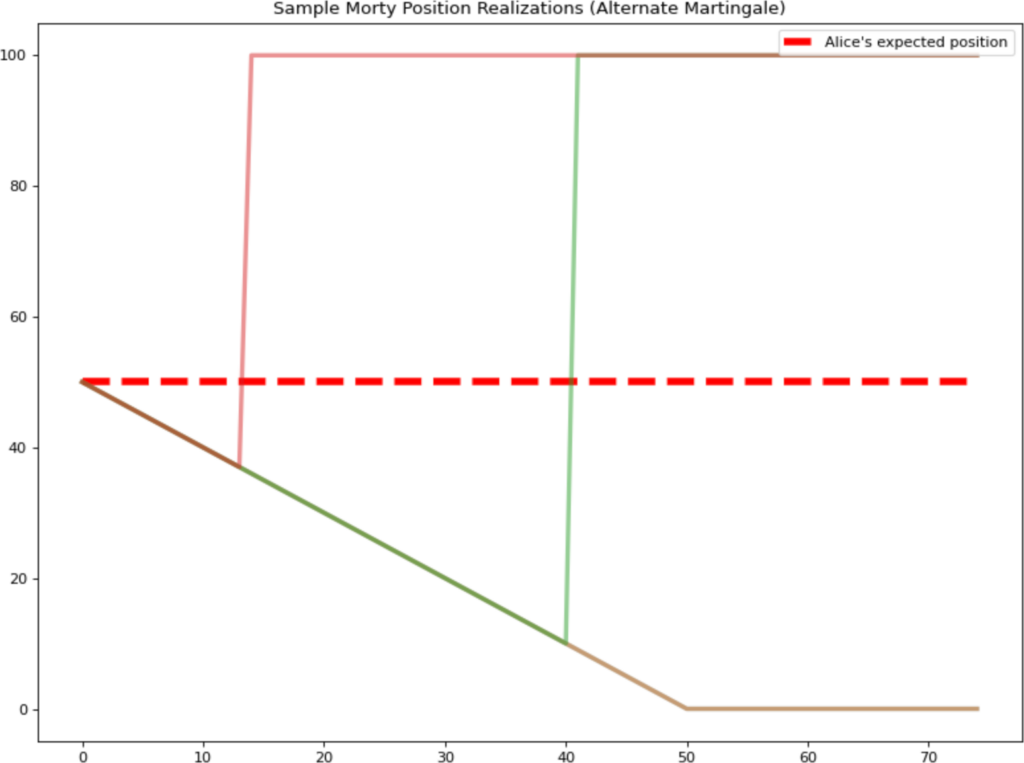Martingale Shares
Sep 14, 2021 | Dave White
Contents
Summary
This paper introduces a new NFT primitive: Martingale shares, or "Mortys."
Mortys are synthetics representing fractional ownership of classes of NFTs.
They do not require buyouts or oracles, but instead rely on a random Martingale settlement process.
Mortys are highly speculative, and should be thought of as something between a protocol design and a thought experiment.
Motivation

Imagine Alice owns an Ocelot from the Awful Hot Ocelots series.
When she bought this Ocelot, it wasn't worth much. However, the project has taken off since then, and she would like to get some liquidity and reduce her price exposure.
She doesn't want to sell her Ocelot outright, as she is using it as her profile picture on Twitter and is otherwise very attached to it. Ideally, she would like to sell 50% of it.
The Challenge of Fractionalization
If she wanted to sell 50% of a plate of cookies, she could just sell half of them. If she wanted to sell 50% of a business, she could sell shares representing the right to receive 50% of the cashflows it generated.
Her Ocelot, however, is not naturally divisible, and does not generate any cashflows. How can it be divided in a way that makes economic sense?
fractional
fractional.art would let Alice fractionalize her Ocelot by selling tokens good for a 50% cut of the proceeds from its eventual future sale. This means fractional has to ensure this future sale will be fair and will actually happen. As a result, the protocol implements a buyout mechanism enabling interested buyers to start an auction on the Ocelot at any time.
This works very well for notable and unique NFTs that have a lot of market interest. However, for more run-of-the-mill NFTs, like Alice's Ocelot, the situation is a little tougher.
Fractional shares of her Ocelot would be a brand new token, and Alice would have to spin up a new market for them somewhere like Uniswap. Because many Ocelots have already been fractionalized, she suspects it will be hard to attract enough attention to sell her shares at a reasonable price.
Similarly, if someone initiates a buyout auction for her Ocelot later, it might not attract that much attention or liquidity, potentially leading to a sale at an unfavorable price for Alice.
Floor Perps
Alice could also use her Ocelot to mint some floor perps, synthetics that track the floor price of Ocelots using a funding rate mechanism and an oracle for the floor price.
However, her Ocelot is worth significantly more than the floor because it has the comparatively sought-after Wizard Hat attribute.

She could theoretically create a floor perp tracking the floor price of just Wizard Hat Ocelots, but that would require defining an oracle for the Wizard Hat Ocelot floor. Because there are just 200 Wizard Hat Ocelots, any such oracle would likely be inaccurate and subject to manipulation.
Lottery Fractionalization
In a recent blog post, Vitalik Buterin offers one possible solution: Alice can sell fractions in the form of lottery tickets.
For example, imagine Alice's Ocelot is worth 10 ETH.
If she sold half of her Ocelot to Bob as a lottery ticket, he would give her 5 ETH and she would give him a 50% chance to win the Ocelot by flipping a coin. If it came up heads, Alice would get the Ocelot back. If it came up tails, Bob would get the Ocelot.
Similarly, if Alice sold 10% of her Ocelot to Bob, he could give her 1 ETH and they could roll a 10-sided die. If it came up 1, Bob would get the Ocelot, and if it came up 2 through 9, Alice would get it.
The advantage of this arrangement is that it is completely and totally fair: the amount of ETH Bob pays is exactly equal to the expected value of the lottery ticket he receives. There are no messy liquidity dynamics around potential buyouts, and there is no concern about oracle price validity. If Bob buys 10% of the Ocelot, he has a 10% chance of getting the Ocelot, period.
However, Alice may still not be too comfortable with this deal. After all, she likes her Ocelot for more than its cash value. Here, she has a 10% chance of immediately losing it.
Furthermore, lottery fractionalization does nothing to help Alice find liquidity or a fair price. In this example, we assumed Alice and Bob both agreed that her Ocelot was worth 10 ETH. In real life, this is unlikely to be true, and Alice may either have to hold an auction or negotiate with Bob privately in order to set a price.
Martingale Fractionalization
Martingale Fractionalization addresses these issues while keeping the perfect mathematical fairness of lottery fractionalization.
Like lottery fractionalization, Martingale fractionalization depends on randomness to settle ownership: Alice sells 50% of her Ocelot in the form of Martingale Shares, or Mortys.
Over time, her remaining ownership will shrink and grow at random in a process known as a Martingale, meaning it is fair at every step. The process ends when her ownership has either dropped to 0% or returned to 100%. Because this settlement takes place over time, these shares can be traded on markets like Uniswap, facilitating liquidity and price discovery.
At any time, Alice may replace the Ocelot she used as collateral with any other Wizard Hat Ocelot. This means that Mortys do not represent fractions of her particular Ocelot, but rather fractions of the cheapest to deliver, or floor, Ocelot of their class. This feature, along with Alice's ability to buy back Wizard Hat Ocelot Mortys on the open market, allows Alice to recover her Ocelot if luck turns against her.
Mechanism Details
Opening a Vault
Alice opens up a new Wizard Hat Ocelot vault with her Wizard Hat Ocelot as collateral. This vault starts with a balance of 100 Wizard Hat Ocelot Martingale Shares (or Wizard Hat Ocelot Mortys).
As mentioned, Alice may replace the Wizard Hat Ocelot she is using as collateral with any other Wizard Hat Ocelot at any time.
Morty Classes
Alice's vault and Mortys are of the Wizard Hat Ocelot class, meaning they can be created only with Wizard Hat Ocelots. All Mortys of a given class are fungible. This is analogous to the situation in Maker, where all DAI is fungible even though it has been created by different people in different vaults with different collateral.
Alice could have chosen a class with stricter requirements, such as Ocelots with both a Wizard Hat and a Scarf. Or, she could have chosen a class with looser requirements, such as the floor Ocelot class, which could be created with any Ocelot at all. More complex classes are possible, such as a class of Mortys that can be minted with either one Ocelot or two Armadillos, NFTs from an entirely different project.
In this case, she chose to mint Wizard Hat Ocelot Mortys because they had the best combination of price and existing liquidity on Uniswap.
Selling Mortys
Alice sells 50 of her Mortys on the Wizard Hat Ocelot Morty / ETH market on Uniswap, reducing the balance in her vault to 50 Mortys.
The Buy Pool
From the perspective of the buyers (in this case the Uniswap LPs) nothing connects these Mortys to Alice's particular vault. Instead, each Morty represents one share of ownership in the Wizard Hat Ocelot buy pool, which collectively forms the counterparty to Alice and all the other Wizard Hat Ocelot vault owners.
Martingale Settlement
Now that Alice's vault balance is no longer at 100, the process of Martingale Settlement begins.
Every night at midnight, the Morty protocol flips one coin per vault. If the coin comes up heads, Alice gives one of her Mortys to the buy pool. If it comes up tails, the buy pool gives one of its Mortys to Alice.
So, after the first flip, either Alice will have 51 Mortys and the buy pool will have 49, or Alice will have 49 Mortys and the buy pool will have 51.
This process repeats every day until Alice has either 0 Mortys or 100 Mortys. If she has 0 Mortys, she gives whatever Ocelot is currently in her vault to the buy pool. If she has 100 Mortys, she gets her Ocelot back. Either way, the process ends.
Martingale Math
Because each coin flip is fair, the process is known as a _Martingale*, meaning that Alice's expected Morty balance never changes.
This means that if Alice has n Mortys on a given day, and does nothing, she has an n% chance of getting her Ocelot back (see here for a proof). In other words, by selling 50 Mortys to the buy pool, Alice really was selling 50% of her Ocelot.

Seller NFT Recovery
Alice has two different ways of recovering her Ocelot if luck turns against her.
The first way is to replace the Ocelot in her vault with another one she values less.
The second way is to mint new Wizard Hat Ocelot Mortys, or buy them on the open market, and use them to increase her vault balance, possibly all the way to 100.
Buy Pool Settlement
If a vault's balance reaches 0, ownership of whatever Ocelot is inside it reverts to the buy pool, at which point many different design choices are possible.
As an example, the Ocelot might go into an NFTX-style vault where it can be redeemed by anyone for the cost of 100 Mortys, plus a fee to incentivize pool liquidity. Viewed this way, Mortys can be seen as a potential extension to protocols like NFTX.
Incentives
Vault Owner Incentives
When Alice chooses to mint and sell Mortys using her Ocelot, she takes on the risk of losing it. Why would she ever do this?
First, assuming the existence of an active market, she is able to quickly get liquidity at a fair price.
Second, there is likely to be significant demand for long exposure to classes of NFTs like Wizard Hat Ocelots, especially from people who cannot afford to buy an entire Wizard Hat Ocelot themselves. Because Alice is servicing this demand, and taking on risk in doing so, she may be compensated in the form of higher prices than she could get by selling her Ocelot outright.
Third, although Alice is now exposed to Martingale risk, she has laid off a good chunk of her Wizard Hat Ocelot floor price risk. Depending on the volatility of Ocelot prices, her overall risk may be significantly decreased.
Vault Incentivization
The existence of liquid Morty markets could be very useful for the ecosystems of their parent NFTs. For example, Morty prices could serve as indices for floor perps.
Given the important role of vault owners, it might make sense to directly incentivize them. For example, a floor perp protocol might divert some of its profits to compensating Morty vault owners who use their shares to LP in the Morty market on Uniswap.
Bad Faith Recovery
The purpose of Martingale settlement is to ensure that Morty buyers have a probabilistic claim to receive NFTs. However, there is a potential attack vector that could stop this from happening.
If Alice has opened 50 different vaults, on average she will lose 25 Mortys and gain 25 Mortys every flip. By moving these Mortys around between her vaults, she can stabilize their balances for a long time.
In the event that this behavior becomes widespread, and has a negative impact on the perceived value or utility of Mortys, a Morty protocol could charge vault owners a fee when they add Mortys to their vaults and forward the revenue to the buy pool.
An even simpler solution would be to turn off the ability to add Mortys back to a vault, since the ability to swap collateral still allows vault owners to rescue NFTs they do not want to lose.
Buy Pool Risk
Alice's risk in this system is relatively easy to understand: if her vault balance is 50 Mortys and she does nothing, she has a 50/50 chance of losing her Ocelot.
The situation for buyers is a bit more complicated.
Base Case
First, imagine the only vault owner in the system is Alice, who has sold 10 Mortys, 5 to Bob and 5 to Charlie. If Alice wins her first coin flip and wins 1 Morty, Bob and Charlie collectively lose 1 Morty, or 0.5 Mortys each — a full 10% of their positions.
More Vaults
However, as there are more and more vaults, Bob's and Charlie's comparative risks start shrinking. Let's say there are
Auto-Canceling Flips
If there are at least two vaults, we can eliminate long variance entirely.
Imagine there is an even number of vaults, say, 4. In that case, we can pair them off at random and only flip one coin per pair, such that a flip of "heads" in the first member of the pair is automatically translated into a flip of "tails" in the second member. Note that while we are reducing the number of bits of randomness in the system, each individual vault still experiences a Martingale.
In this way, even though individual vault balances will change from flip to flip, the number of outstanding long Mortys will never change. We can use this method even if there is an odd number of short vaults, simply by choosing one vault at random to exclude from the current round of flips.
Alternative Martingales
We can also change the random process used for settlement as long as it is still a Martingale.
The coin-flipping process described above, for example, can take quite a while to finish. What if we designed a process guaranteed to end in a fixed amount of time?
Let's say Alice's vault is short
For example, if Alice has just minted and sold 2 Mortys, so that she has a balance of 98 Mortys, she would have a
At every time step, Alice either gets her short closed out and can recover her NFT, or gets her short position increased by one Morty. Unless she buys or mints more Mortys and adds them to her vault, the process will always end within 100 time steps.

Conclusion
Mortys are a strange but mathematically pure way to create fractional exposure to classes of NFTs.
It is unclear how much market demand for them there may be, but they are certainly fun to think about.
If they have captured your imagination, I would love to hear from you. You can email me at dave@paradigm.xyz, or tag @Dave__White on Twitter.
Acknowledgments: Dan Robinson, Kevin Pang, Matt Huang, Jim Prosser, Grug, andy8052, Doug Colkitt, CL, Mewny, Andrew Badr, Sunny Aggarwal, lsf, Anna Carroll, Allan Niemerg, 0xmons, Big Magic, miyuki, ayko2718, Kamil Sadik, nnnnicholas, KND
Disclaimer: This post is for general information purposes only. It does not constitute investment advice or a recommendation or solicitation to buy or sell any investment and should not be used in the evaluation of the merits of making any investment decision. It should not be relied upon for accounting, legal or tax advice or investment recommendations. This post reflects the current opinions of the authors and is not made on behalf of Paradigm or its affiliates and does not necessarily reflect the opinions of Paradigm, its affiliates or individuals associated with Paradigm. The opinions reflected herein are subject to change without being updated.